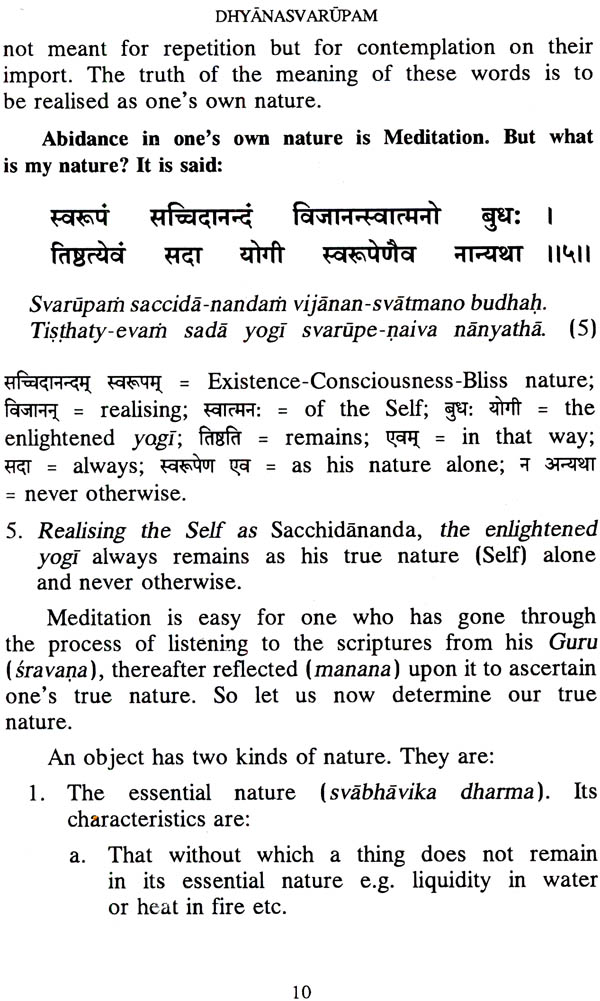
Dhyanasvarupam
Book Specification
| Item Code: | NAC802 |
| Author: | Swami Tejomayananda |
| Publisher: | Central Chinmaya Mission Trust |
| Language: | (Sanskrit Text, Roman, Word-to-Word Meaing, English Translation and Detailed Explanation) |
| Edition: | 2011 |
| ISBN: | 9788175971271 |
| Pages: | 27 |
| Cover: | Paperback |
| Other Details | 8.5 Inch X 5.5 Inch |
| Weight | 40 gm |
Book Description
In one of his Vedantik texts Pancadasi, Svami Vidyaranya says, Avicara krto bandho vicarena nivartate-All bondage is due to either total lack of thinking, incomplete thinking or wrong thinking. It can be removed by proper and complete thinking. Writing one’s thoughts at times aids the process of reflection. With the above points in view I pennd Dhyanasvarupam in Washington during Pujya Gurudeva, Swami Chinmayananda ji’s camp in 1993. Pujya Gurudeva liked the text and blessed it.
Here the text and a commentary of Dhyanasvarupam is put forth with the hope that it will help the seekers with right understanding of the nature of meditation. In this text, the essence of meditation alone is presented.Techniques of meditation are not given here. If a person understands the principle well, then he or she can develop techniques by himself or herself.
It is a well known fact that we love ourselves the most. We may claim to love this or that even more than our life, but the fact remains that we love ourselves the most. There is nothing wrong with it and one need not feel guilty or shy of admitting it. This love manifests in every little action of ours. We stare endlessly into the mirror or any other reflecting surface, make voluminous photo albums, love to hear our own praises and can speak for hours about ourselves. Self love manifests as the thought- May I always be, May I never cease to be.’ Hence we try to protect and preserve ourselves even at the cost of another’s life or loads of money. Do we not pat with our life-long saving for the sake our life?
Love for the self is the most important and interesting fact of life. Unfortunately we do not know our own true self and there lise the problem. We consider ourselves as a finite, perishing entity, the BMI (body-mind-intellect) and suffer. This identification with the finite makes us extremely selfish. But suppose, one were to realize that the self in me is the self in all, ‘there would be no trace of selfishness, but only love for all. This realization releases us from all bondages even while acting in the world.
In the Brhadaranyaka Upanisad the Guru Sage Yajnavalkya tells his disciple, his wife Maitreyi Atmanastu kamaya sarvam priyam bhavati’’-All are dear to one self for the sake of the Self i.e., we love ourselves the most. We love other only if they are a source of happiness to us. Therefore one should see one’s true Self. (Atma va are drastavyah). Generally to see any object we use our eyes. The Self being the subject can never be known as an object of perception. Hence here seeing the Self means knowing it. We know of anything by hearing or reading about it. For example, you would not know, this is such and such object if you were not told so, despite seeing it, Therefore to see the self we should here about it (srotavyah). When we here about Self-knowledge, we many not understand or partially understand and therefore doubts arise. Our knowledge and experience may seem to contradict what the teacher says. He says we are not the body and that we are the source of all joy. We experience just the apposite. Doubts arise in the intellect, and have to be removed for the clear understanding to take place. The Doubts an be removed only by reflection. Hence Sage Yajnavalkya saya: One should reflect (Mantavyah) on the Self.’’
Knowledge may be doubtless, and one may even gain a glimpse of the Self. But due to habitual error and the impurities of mind one may not be able to establish oneself in the Truth. One is, therefore unable to enjoy the promised Infinite bliss of the self-realisation, to attain which the sage finally says: one should meditate (Nididhyasitavyah).’’
In the text, We shall only talk on meditation. Meditation is in vogue and many seem to be interested in it and practicing it. In these days of instant coffee, two minute noodles and jet-speed travel, people seek instant realisation through quick means, by instant meditation. But there is not short cut to meditation or realisation, Many aspirants practise meditation but do not know what meditation is, the nature of the meditator and the self meditated upon, the obstacles and the means remove them,the result etc. When the mind is thus unprepared, sitting for meditation is of little use. Many sit in meditation and only experience agiyation. Hence the underlying principle of meditation now explained.
Presently many techniques of meditation are spoken of and one is asked, What is your technique?’ Here the Upanisadik or Vedantik understanding of meditation is explained. It is nothing new, but a time tested and an ancient method of meditation.
The beauty of the work is that the subtle subject matter of spiritual sadhana is conveyed in very simple terms. The Master comes down to the level of ordinary sadhaka-s nay novices and guides them step-by-step to the heights of meditation in a language easily intelligible ever to layman.
Dhyanasvarupam. i.e. Meditation is the shortest treatise of the four steps. These ten brief and simple verses with the help of examples from day to day life explain that meditation is neither worship (upasana) nor japa nor concentration nor even action. Meditation is just abidance in Self i.e., in one's own true nature. Thereafter, the principle behind and the technique of meditation is elucidated in an easy to follow style.







